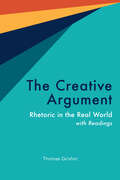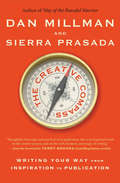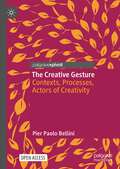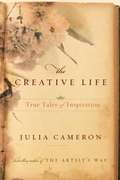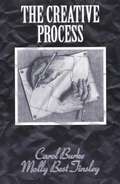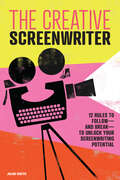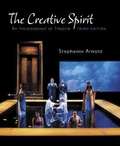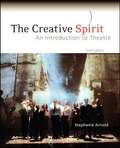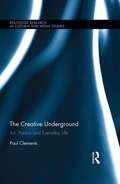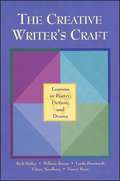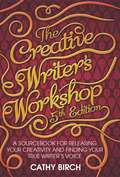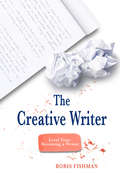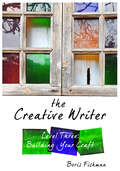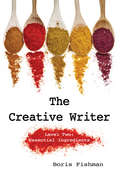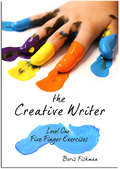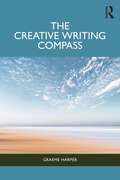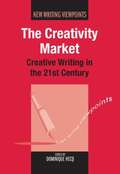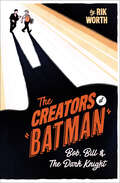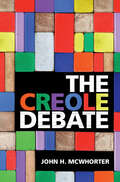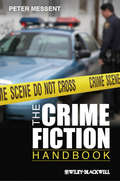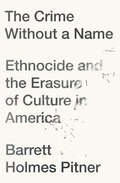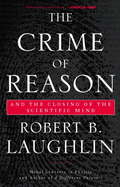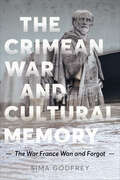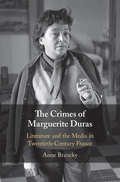- Table View
- List View
The Creative Argument: Rhetoric in the Real World, with Readings
by Thomas GirshinThe Creative Argument sets itself apart from its competitors by presenting a series of compelling works of literary nonfiction that challenge what students think they know about arguments. Each chapter begins with an engaging argument from a work of nonfiction, followed by an in-depth yet accessible analysis of a key aspect of argumentation. Suitable for both courses in argument and first-year writing, the principles and strategies outlined in the text help students become more creative and critical as rhetoricians, both inside the classroom and out.
The Creative Compass
by Dan Millman Sierra PrasadaA guide should give clear directions and then get out of your way. In this unique collaboration, bestselling author Dan Millman and his daughter Sierra Prasada help to orient you as you advance through five universal stages of creativity: Dream, Draft, Develop, Refine, and Share. Whether you're seeking new goals, the discipline to reach them, a shield against self-doubt and inertia, or practical advice on sorting through feedback and connecting with readers -- you'll find a way forward in this fresh approach to writing and storytelling. Drawing on the coauthors' personal stories about overcoming challenges, as well as sage advice from other writers, artists, and innovators, The Creative Compass will transform both the stories you tell and the stories you live.
The Creative Gesture: Contexts, Processes, Actors of Creativity (Palgrave Studies in Creativity and Culture)
by Pier Paolo BelliniThis open access book offers a concise overview of the theories constructed within the various human sciences around the theme of creativity as a symbolic capacity to link things together: it manifests itself when the individual endowed with a certain type of intelligence encounters cultural and social conditions that enable them to develop that capacity to the maximum, rather than inhibiting it or diverting it to other fields where it is doomed to failure. Even the most intimate of human expressiveness is considered as a result of an active social relationality. Social dimensions of creativity (evaluation, primary socialization, motivation, leadership) and “creative processes” (creative attitude, creative gesture, divergent thinking, problem-solving capacity, interdisciplinary approach, randomness, algorithmic creativity) are also analysed.The book concludes by evaluating the course taken in the light of the relational theory of society: the development of creativity cannot beconceived outside of self-other relations.This book is the result of a translation done with the help of artificial intelligence. The text has subsequently been revised further by a professional copy editor in order to refine the work stylistically.
The Creative Life: True Tales of Inspiration
by Julia CameronIn The Creative Life , bestselling author of The Artist's Way Julia Cameron parts the curtain on her own life to reveal a world rich with creative possibility. According to Julia Cameron, when we allow our creative spirit to serve as our compass, we discover that the art we have always longed to create is suddenly within our grasp. In this book, she shows readers how to use their creative hearts and minds to cultivate lives that nourish and sustain their art. Through beautifully drawn scenes from her own life, as well as the lives of the many artists around her, Cameron reveals that creativity flourishes during the quiet pauses in our lives—and that it is only when we allow ourselves to slow down and savor life that we uncover ways to depict it sensitively and poetically in our art. .
The Creative Process
by Carol Burke Molly Best TinsleyA process approach to creative writing, emphasizing open-ended exploratory writing through carefully focused exercises and journal-writing activities. Focuses on writing poems, stories, and essays, with samples by professionals and students that illustrate techniques.
The Creative Screenwriter: 12 Rules to Follow—and Break—to Unlock Your Screenwriting Potential
by Julian HoxterMaster the craft of screenwriting—12 steps to bring your creative vision to the screen It can be difficult to find a modern resource that teaches you the nuts and bolts of screenwriting while also allowing you the freedom to creatively thrive. This guide distills the craft of screenwriting into 12 key elements, from developing your story to revising and rewriting, plus plenty of inspiration to create your own screenplay with confidence. Discover what to expect within the film industry and how it has evolved. Look behind the scenes at iconic films using a classic structure of screenwriting, along with experimental films from innovative writers that have transcended the rules and paved their own way to the silver screen. Then, get to the exciting part—writing—using a dozen tried-and-true rules of the trade. Each chapter is accompanied with an In the Writer's Room creative exercise, such as formatting your script, mapping sequences, and creating rich dialogue and characters, to deepen your understanding of what brings a screenplay to life. This screenwriting guide includes: Filmmaker's dozen—From loglines to creating a compelling character to root for, you'll find 12 fundamental but flexible steps to help you craft a powerful, creative screenplay. Topline terminology—Navigate the film biz like a pro with need-to-know Hollywood jargon, plus troubleshooting tips for any screenwriting hiccups along the way. Film archive—From William Goldman's The Princess Bride to Taika Waititi's Jojo Rabbit, discover emerging and timeless screenwriting techniques used in Hollywood blockbusters, micro-budget films, and more. Take your story from creative conception to complete script with this modern, 12-step approach to screenwriting.
The Creative Spirit: An Introduction to Theatre
by Stephanie ArnoldIncludes discussion of each playwright's other works, sources, timelines for historical and cultural context, and the production of the plays.
The Creative Spirit: An Introduction to Theatre
by Stephanie ArnoldFocusing on the collaborative and creative processes that go into productions, The Creative Spirit: An Introduction to Theatre introduces students to the theatre through the plays themselves and the people who write them, create them, and act in them. The book provides a rich context for each play with a discussion of the playwright's other works, sources for the play, timelines that present historical and cultural background, and a section on a particular production of the play to give students a sense of the theatre industry at close hand. The Creative Spirit includes complete scripts of five plays: August Wilson's Joe Turner's Come and Gone, Wakako Yamauchi's And the Soul Shall Dance, Tony Kushner's Angels in America, Milcha Sanchez-Scott's Dog Lady, and Nilo Cruz's Anna in the Tropics.
The Creative Underground: Art, Politics and Everyday Life (Routledge Research in Cultural and Media Studies)
by Paul ClementsPaul Clements champions the creative underground and expressions of difference through visionary avant-garde and resistant ideas. This is represented by an admixture of utopian literature, manifestos and lifestyles which challenge normality and attempt to reinvent society, as practiced for example, by radicals in bohemian enclaves or youth subcultures. He showcases a range of 'art' and participatory cultural practices that are examined sociopolitically and historically, employing key theoretical ideas which highlight their contribution to aesthetic thinking, political ideology, and public discourse. A reevaluation of the arts and progressive modernism can reinvigorate culture through active leisure and post-work possibilities beyond materialism and its constraints, thereby presenting alternatives to established understandings and everyday cultural processes. The book teases out the difficult relationship between the individual, culture and society especially in relation to autonomy and marginality, while arguing that the creative underground is crucial for a better world, as it offers enchantment, vitality and hope.
The Creative Writer's Craft: Lessons in Poetry, Fiction, and Drama
by Mcgraw-Hill Staff Richard BaileyThe Creative Writer's Craft is organized by genre into three sections - Poetry, Fiction, and Drama. It offers students the opportunity to explore and develop crafting skills for writing various types of poems, short stories, and one act plays. The lessons and writing activities encourage students to develop a writer's attitude, embracing the writing process rather than the final result.
The Creative Writer's Workshop, 5th Edition: A Sourcebook For Releasing Your Creativity And Finding Your True Writer's Voice
by Cathy BirchThis book aims to get you writing and keep you writing - and help you enjoy your writing to the full. It will show you how to free your own unique voice and create original, individual work. It is packed with exercises, visualisation techniques, flow charts, dream-work and word webs that will enable you to explore the treasures of your subconscious, revisit your childhood world of games and make believe, and bring back what you find. Then it shows you how to harness that creativity in developing your characters, settings, plot and dialogue. Additional exercises focus on sustaining your own motivation, providing the perfect setting in which to develop your writing. This book will help you at every stage. Use it to rediscover your love of words and the spontaneity in your writing. Find your voice and become the writer you were meant to be.Contents: 1. Writing as a Way of Life; 2. Tuning In; 3. Discovering the Plot; 4. Developing Atmosphere, Pace and Mood; 5. Working with Beginnings and Endings; 6. Surprise Yourself; 7. Working With Your Dreams; 8. Recycling; 9. Crafting Your Work; 10. Editing Your Work; Glossary; References; Further reading; Useful addresses and websites; Index.
The Creative Writer's Workshop, 5th Edition: A Sourcebook for Releasing Your Creativity and Finding Your True Writer's Voice
by Cathy BirchThis book aims to get you writing and keep you writing - and help you enjoy your writing to the full. It will show you how to free your own unique voice and create original, individual work. It is packed with exercises, visualisation techniques, flow charts, dream-work and word webs that will enable you to explore the treasures of your subconscious, revisit your childhood world of games and make believe, and bring back what you find. Then it shows you how to harness that creativity in developing your characters, settings, plot and dialogue. Additional exercises focus on sustaining your own motivation, providing the perfect setting in which to develop your writing. This book will help you at every stage. Use it to rediscover your love of words and the spontaneity in your writing. Find your voice and become the writer you were meant to be.Contents: 1. Writing as a Way of Life; 2. Tuning In; 3. Discovering the Plot; 4. Developing Atmosphere, Pace and Mood; 5. Working with Beginnings and Endings; 6. Surprise Yourself; 7. Working With Your Dreams; 8. Recycling; 9. Crafting Your Work; 10. Editing Your Work; Glossary; References; Further reading; Useful addresses and websites; Index.
The Creative Writer, Level Four (The Creative Writer)
by Boris FishmanThe culminating volume in the four-book series that guides students into the creation of sophisticated short fiction and mature poetry. Building on the skills taught in the first three levels, The Creative Writer, Level Four: Becoming a Writer guides young writers from idea to polished short story or poem in a single volume. Becoming a Writer also walks students through the transition from study to practice, broadening the series' focus by discussing the writing life -- how to find and submit to literary journals, how to develop discipline, and how to persevere in the face of rejection. Reviews and strengthens the writer's grasp on the five essentials of fiction: plot, character, dialogue, point of view, and setting. Guides the writer into the effective, sophisticated use of the essentials of poetry: sound, rhythm, word choice, and structure. All exercises build toward the production of mature, finished creative piece Can be used as a complement to Writing With Skill or on its own.
The Creative Writer, Level Three: Building Your Craft (The Creative Writer)
by Boris FishmanThe third volume of the four-book series that guides students into the creation of sophisticated short fiction and mature poetry. * Complements Peace Hill Press's expository series Writing With Skill by providing the imaginative element that many students want. * Unlike most "how to write" books, these are designed to be used in a mentor/student relationship, with teaching, guidance, and evaluation tips provided for the mentor or teacher. * All exercises build towards the production of finished creative pieces * Sequential, logical, step-by-step instruction * The third level builds on the introductory volume, The Creative Writer: Five Finger Exercises, but can be started directly by older students. * Instruction in the five essentials of fiction: plot, characters, dialogue, point of view, and setting. Level Three leads students into the construction of more complex plots, evocative settings, and three-dimensional characters * Guidance in the essential art of poetry: sound, rhythm, word choice, and poem construction. Level Three draws students into even more sophisticated use of words and themes.
The Creative Writer, Level Two: Essential Ingredients (The Creative Writer)
by Boris FishmanThe second volume of the four-book series that guides students into the creation of sophisticated short fiction and mature poetry. Complements Peace Hill Press's expository series Writing With Skill by providing the imaginative element that many students want. Unlike most "how to write" books, these are designed to be used in a mentor/student relationship, with teaching, guidance, and evaluation tips provided for the mentor or teacher. All exercises build towards the production of finished creative pieces. Sequential, logical, step-by-step instruction. The second level builds on the introductory volume, The Creative Writer: Five Finger Exercises, but can be started directly by older students. Instruction in the five essentials of fiction: plot, characters, dialogue, point of view, and setting. Offers guidance in the essential art of poetry: sound, rhythm, word choice, and poem construction.
The Creative Writer: Five Finger Exercises (The Creative Writer)
by Boris FishmanA gentle, imaginative introduction to the skills all creative writers need. Breaking down the elements that go into successful imaginative works, The Creative Writer leads aspiring writers through the skills needed to construct each. The assignments, designed to make students more aware of language and more confident in their own ingenuity, build on each other until beginning creative writers have successfully created their own stories, poems, and essays. * Simple but innovative exercises encourage young writers to strengthen their vocabulary and become aware of the patterns of sentences * Legends and folklore are used to teach point of view, characterization, plotting, and other vital skills * Classic poetry serves as a model for the student's own original poems * Unlike most "how to write" books, The Creative Writer is designed to be used in a mentor/student relationship, with teaching, guidance, and evaluation tips provided for the mentor or teacher * Can be used as a complement to Writing With Skill or on its own
The Creative Writing Compass
by Graeme HarperThe Creative Writing Compass presents a dynamic navigational instrument for creative writers and those learning to be creative writers, providing a method for developing and advancing knowledge of creative writing. Award-winning novelist Graeme Harper explores the many fluid interactions of the imagination and the physical acts of writing. He includes observations and approaches that can be personalized to assist with writing decisions. This distinctive guide to the practice of creative writing and to its critical understanding is based in the actions of creation and in each individual writer’s responses to those actions. The ‘compass’ refers to the range of outcomes produced in creative writing – from finished works to the experiences creative writers have while writing – as well as to the range of forces, influences, and meanings that any writer is likely to encounter along the way. The Creative Writing Compass is a guide to the consideration, progression, and completion of creative writing projects, providing ways of thinking about work-in-progress as well as ways of determining and reflecting on end results.
The Creativity Market
by Dominique HecqThis book focuses on creative writing both as a subject in universities and beyond academia, with chapters arranged around three organising sub-themes of practice, research and pedagogy. It explores the 'creative' component of creative writing in the globalised marketplace, making the point that creative writing occurs in and around universities throughout the world. It examines the convergence of education, globalisation and economic discourses at the intersection of the university sector and creative industries, and foregrounds the competing interests at the core of creativity as it appears in the neo-liberal global discourse in which writers are enmeshed. The book offers case studies from the UK, the USA, Canada, Australia and Singapore that are indicative of the challenges faced by academics, postgraduate students and creative industry professionals around the world.
The Creators of Batman: Bob, Bill & The Dark Knight
by Rik WorthFrom an Eisner Award nominee: The story of Bob Kane, Bill Finger, and the real origins of the legendary crimefighter.In the early twentieth century, the emerging medium of comics was beginning to grab the attention of children and adults alike. Then, in the 1930s, superheroes revolutionized the entire industry—and culture as we know it. Gotham’s caped crusader, The Batman, swung into this pantheon of demi-gods in 1939 and secured his place as one of the world’s most beloved characters. This fascinating account dwells into how artist Bob Kane got all the credit for Batman’s origin while his co-creator, Bill Finger, was forced into the shadows, and how comic creators, journalists, and family members fought to have Finger credited for his work. The first prose book to focus on both Finger and Kane as well as cast of supporting characters from one of the most exciting times in comic book history, The Creators of Batman: Bob, Bill and The Dark Knight gathers everything we know about these two monumental figures and lays their stories side by side. Bringing together the story of these two creators against the exciting background of the American comic’s boom and Batman’s Golden Age, it looks at how Finger and Kane constructed the world of Gotham and its denizens, and grapples with the legacy the creators left behind.
The Creole Debate
by John H. McWhorterCreoles have long been the subject of debate in linguistics, with many conflicting views, both on how they are formed, and what their political and linguistic status should be. Indeed, over the past twenty years, some creole specialists have argued that it has been wrong to think of creoles as anything but language blends in the same way that Yiddish is a blend of German and Hebrew and Slavic. <P><P>Here, John H. McWhorter debunks the most widely accepted idea that creoles are created in the same way as 'children', taking characteristics from both 'parent' languages, and its underlying assumption that all historical and biological processes are the same. Instead, the facts support the original, and more interesting, argument that creoles are their own unique entity and are among the world's only genuinely new languages.<P> Presents data from a wide range of creoles, not just the restricted few that are largely studied by uniformitarians.<P> Presents counter arguments to the uniformitarian view, which many linguists will have had little exposure to before.<P> Reveals creole studies to be far more widely ranging than often thought, including answering the oft-posed question as to what would happen if creoles were based on languages beyond Europe and Africa.
The Crime Fiction Handbook
by Peter MessentThe Crime Fiction Handbook presents a comprehensive introduction to the origins, development, and cultural significance of the crime fiction genre, focusing mainly on American British, and Scandinavian texts. Provides an accessible and well-written introduction to the genre of crime fiction Moves with ease between a general overview of the genre and useful theoretical approaches Includes a close analysis of the key texts in the crime fiction tradition Identifies what makes crime fiction of such cultural importance and illuminates the social and political anxieties at its heart. Shows the similarities and differences between British, American, and Scandinavian crime fiction traditions
The Crime Without a Name: Ethnocide and the Erasure of Culture in America
by Barrett Holmes PitnerIn this incisive blend of personal narrative and philosophical inquiry, journalist and activist Barrett Holmes Pitner seeks a new way to talk about racism in America.Can new language reshape our understanding of the past and expand the possibilities of the future? The Crime Without a Name follows Pitner&’s journey to identify and remedy the linguistic void in how we discuss race and culture in the United States. Ethnocide, first coined in 1944 by Jewish exile Raphael Lemkin (who also coined the term "genocide"), describes the systemic erasure of a people&’s ancestral culture. For Black Americans, who have endured this atrocity for generations, this erasure dates back to the transatlantic slave trade and reached new resonance in a post-Trump world. Just as the concept of genocide radically reshaped our perception of human rights in the twentieth century, reframing discussions about race and culture in terms of ethnocide can change the way we understand our diverse and rapidly evolving racial and political climate in a time of increased visibility around police brutality and systemic racism. The Crime Without a Name traces the historical origins of ethnocide in the United States, examines the personal, lived consequences of existing within an ongoing erasure, and offers ways for readers to combat and overcome our country&’s ethnocidal foundation.
The Crime of Reason: And the Closing of the Scientific Mind
by Laughlin Robert B.We all agree that the free flow of ideas is essential to creativity. And we like to believe that in our modern, technological world, information is more freely available and flows faster than ever before. But according to Nobel Laureate Robert Laughlin, acquiring information is becoming a danger or even a crime. Increasingly, the really valuable information is private property or a state secret, with the result that it is now easy for a flash of insight, entirely innocently, to infringe a patent or threaten national security. The public pays little attention because this vital information is "technical”--but, Laughlin argues, information is often labeled technical so it can be sequestered, not sequestered because it’s technical. The increasing restrictions on information in such fields as cryptography, biotechnology, and computer software design are creating a new Dark Age: a time characterized not by light and truth but by disinformation and ignorance. Thus we find ourselves dealing more and more with the Crime of Reason, the antisocial and sometimes outright illegal nature of certain intellectual activities. The Crime of Reason is a reader-friendly jeremiad, On Bullshit for the Slashdot and Creative Commons crowd: a short, fiercely argued essay on a problem of increasing concern to people at the frontiers of new ideas.
The Crimean War and Cultural Memory: The War France Won and Forgot
by Sima GodfreyThe Crimean War (1854–56) is widely considered the first modern war with its tactical use of railways, telegraphs, and battleships, its long-range rifles, and its notorious trenches – precursors of the Great War. It is also the first media war: the first to know the impact of a correspondent on the field of battle and the first to be documented in photographs. No one, however, including the French themselves, seems to remember that France was there, fighting in Crimea, losing 95,000 soldiers and leading the Allied campaign to victory. It would seem that the Crimean War has no place in the canon of culturally retained historical events that define modern French identity. Looking at literature, art, theatre, material objects, and medical reports, The Crimean War and Cultural Memory considers how the Crimean War was and was not represented in French cultural history in the second half of the nineteenth century. Ultimately, the book illuminates the forgotten traces that the Crimean War left on the French cultural landscape.
The Crimes of Marguerite Duras: Literature and the Media in Twentieth-Century France
by Anne BranckyOne of the most celebrated authors of twentieth-century France, Marguerite Duras loved crime. Indeed, criminal faits divers from the newspaper represented a key element in her literary project. Sensational news stories made their way into her novels, plays and screenplays, inspired numerous journalistic pieces and media interventions, and even informed the way that she discussed her life and work in the press. The Crimes of Marguerite Duras offers an innovative framework for analyzing Duras's literary works and journalism as they relate to the mass media and broader cultural debates. Anne Brancky reveals how Duras's predilection for provocatively blurring the line between truth and fiction on various media platforms helped make her a best-selling author and a public intellectual ahead of her time. Exploring the movement between serious literature and public scandal, this readable book affirms literature's abiding role in political debate and the public sphere.
